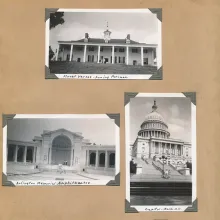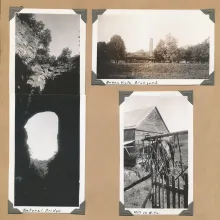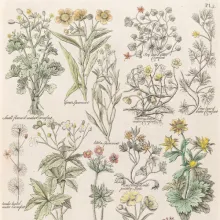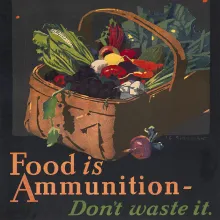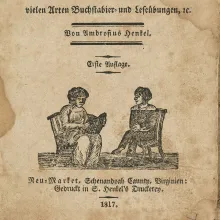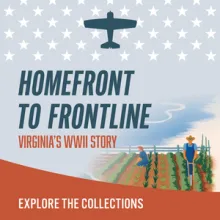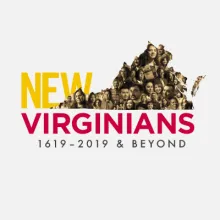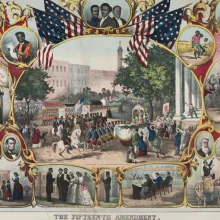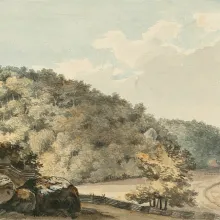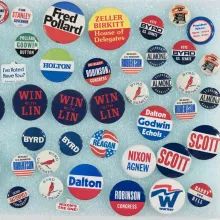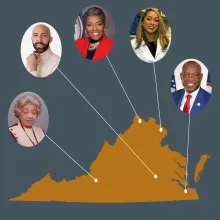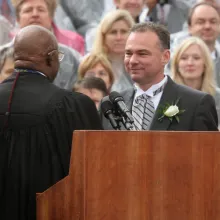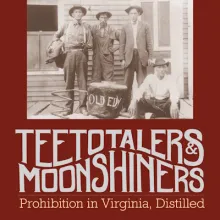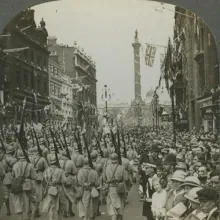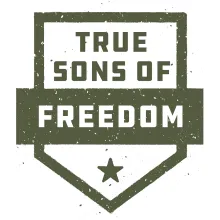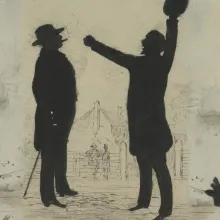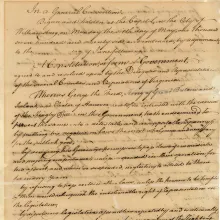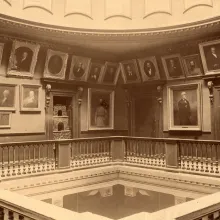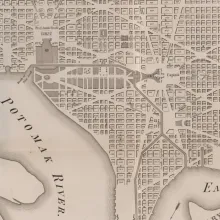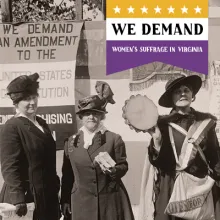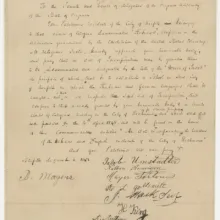In the summer of 1937, 17-year-old Phyllis Jeanette Hughes set out with her family to make a cross-country trip from Santa Barbara, California, to the East Coast and back. They rode by train along the northern route to Michigan, where they continued by car in order to explore the South and visit her father's family in West Virginia. They ventured into Virginia, visiting Natural Bridge before heading north to New England and back south to take the southern route back to California. Hughes kept a daily journal of the trip, adding the type of colorful commentary only a teenager could provide, which reads like a modern-day social media feed. She made a scrapbook from the photographs taken throughout the trip and added her journal entries to the corresponding photographs and ephemera. This exhibit will highlight excerpts from her scrapbook.
Exhibitions: Past and Present
In the summer of 1937, 17-year-old Phyllis Jeanette Hughes set out with her family to make a cross-country trip from Santa Barbara, California, to the East Coast and back. They rode by train along the northern route to Michigan, where they continued by car in order to explore the South and visit her father's family in West Virginia. They ventured into Virginia, visiting Natural Bridge before heading north to New England and back south to take the southern route back to California. Hughes kept a daily journal of the trip, adding the type of colorful commentary only a teenager could provide, which reads like a modern-day social media feed. She made a scrapbook from the photographs taken throughout the trip and added her journal entries to the corresponding photographs and ephemera. This exhibit will highlight excerpts from her scrapbook.
Physical Exhibition:
-
The Library of Virginia, one of the oldest state libraries and archives in the nation, marked its bicentennial in 2023 with an exhibition — "200 Years, 200 Stories." Our exhibition and multimedia experience celebrated more than 200 Virginians whose fascinating narratives are housed in the Library’s collections and together reflect the stories of Virginia.
Physical Exhibition:
-
Political life in Virginia has undergone many changes since the founding of Jamestown in 1607. The changes have often involved debates about who could vote and who could not. The enlargement of the franchise—the right to vote—from an exclusive group of landowners to all Virginians over the age of 18 reflects other changes that have affected the lives of Virginians since the founding of the colony. Being excluded from voting has not always meant being without a voice in politics, and Virginians who lacked the vote often influenced the course of politics in other ways. They made speeches, wrote pamphlets, published books, took part in parades, petitioned the General Assembly, and even engaged in riots. "’A full vote, a free ballot and a fair count’: Political Life in Virginia” examined key events and issues in Virginia's political history and charted the gradual enlargement of the franchise.
Hand colored engravings of North American birds from American Ornithology by Alexander Wilson (1766-1813). This beautiful set of books, published from 1808 to 1825, is considered the first comprehensive work on American natural history and contains 76 full page illustrations.
Take a stroll through our garden! Botanica is an exploration of botanical texts and art through the volumes of the Rare Book Collection at the Library of Virginia. Includes early herbals, which describe plants for their medicinal value (Gerard's Generall Historie of Plantes, 1633 & Salmon's Botanologia: The English Herbal, 1710), as well as textbooks and floras (Elements of Botany by Benjamin Barton Smith, 1804 & Flora Carolinaensis by John Linnaeus Edward Whitridge Shecut, 1806), which study plants scientifically based on their botany and taxonomic relationships. The exhibition also highlights the plant images as art objects which are not only beautiful but portray their subjects faithfully and timelessly.
Physical Exhibition:
-
"Columbia Pike: Through the Lens of Community" celebrated the extraordinary cultural diversity found within a single community in Northern Virginia through a unique exhibition of photographs. Columbia Pike originated in the 19th century as a toll road connecting rural Virginia with the nation’s capital. In the 21st century, the Columbia Pike corridor is one of the most culturally diverse communities in the nation, and possibly in the world. More than 130 languages are spoken in Arlington County, with the densest concentration along the Pike. Unlike in many parts of the world, or even in our own country, however, the stunningly diverse group of people — representing every continent — who live and work there do so in relative harmony.
Food shortages in Europe caused desperation among the Allied nations during WWI. Prior to the U.S. entry into the war, the U.S. became the largest provider of food relief aid. President Woodrow Wilson created and appointed Herbert Hoover head of the U.S. Food Administration on August 10, 1917, four months after the United States entered the war. Hoover believed that food was "second only to military action" during the war. "Food for Fighting" explores how poster art encouraged food conservation on the home front and led to lasting changes in the American diet in the century that followed.
The Alan M. Voorhees Map Collection extends from the 1493 Nuremberg Chronicle through the U.S. Civil War period with the bulk of the collection consisting of pre–20th century maps. Included are maps made by Schedel, Ptolemy, deBry, Mercator, and Smith among many others. In a variety of map formats, such as nautical charts and views, the collection focuses primarily on the Chesapeake Bay area and the development of Virginia within the larger geographical and historical contexts of Europe and America.
These German-American early printed works are items produced by the Henkel Press, established by two brothers, Solomon and Ambrose, in New Market, Shenandoah County, Va. In 1806. Staying true to their German heritage, many items were available in German or bilingual format, particularly the illustrated primers displayed within. The Henkel family also included several prominent Evangelical Lutheran ministers, as well as entrepreneurs, farmers, and early pharmacists. Their broadsides marketing their own medical products and early printed religious works are also found in this visually striking and informative exhibit with materials held in Manuscripts & Special Collections.
Physical Exhibition:
-
"Homefront to Frontline: Virginia's WWII Story," a lobby display, online exhibition and a collection of online resources commemorating the 80th anniversary of World War II, brings to life the experiences of those who served in the military as well as those who supported the war effort at home. The lobby display runs through November 26, 2025, with content rotating in June.
Physical Exhibition:
-
The Library's free exhibition on the history of Richmond's Jackson Ward neighborhood, "House to Highway: Reclaiming a Community History," will explore the historic district that was once the center of Richmond’s Black community through the lens of the Skipwith-Roper family. Using a combination of archival records, maps and photographs from the Library’s collection, the exhibition covers a period from 1767 through the 1950s, when eminent domain displaced many residents and businesses of Jackson Ward for the construction of the Richmond-Petersburg Turnpike.
The exhibition is presented in partnership with The JXN Project (JXN), a historic preservation nonprofit organization dedicated to capturing the pivotal role of the ward in the Black American experience as one of the country’s first historically registered Black urban neighborhoods.
The exhibition is presented in partnership with The JXN Project (JXN), a historic preservation nonprofit organization dedicated to capturing the pivotal role of the ward in the Black American experience as one of the country’s first historically registered Black urban neighborhoods.
Physical Exhibition:
-
Traveling from
through
Indigenous Perspectives examines aspects of our collections through the lenses of the eleven federally and state-recognized Virginia tribes. In these interviews, tribal citizens offer reflections on our exhibition themes of retaining tribal culture, identity, resistance, tribal sovereignty, the land and environment, and the future of Virginia’s tribes that enlarge our understanding of documents in the Library’s collections.
John Mitchell Jr. was the founder of Richmond's first Black newspaper, the Richmond Planet. This online exhibition provides historical context in which to understand Mitchell's life and work. It sheds light on his many contributions to the social and political life of Virginia's African American community while offering a glimpse into twentieth-century newspaper publishing in America.
Traveling from
through
Explore the history of the Lantz Mills Deaf Village in Shenandoah County, Virginia. Between 1740 and 1970, Lantz Mills was home to many families with a mix of hearing and deaf parents and at least one or more deaf siblings. When both the hearing and deaf members of a locality use a shared visual language to communicate, that is known as a shared signing community. Those familiar with deaf culture may know that Martha’s Vineyard, in Massachusetts, was home to a shared signing community where 25% of the population was deaf. But few know about Virginia's deaf village and shared signing community in Shenandoah County.
Physical Exhibition:
-
"Mapping the Commonwealth" presented examples from 40 manuscript maps that highlight the painstaking task of creating Virginia's first official state map, which was published in 1826. Combining art and science, these surveys attest to the dedication, skill and stamina of surveying teams who worked without the benefit of GPS and today's technology.
Physical Exhibition:
-
"New Virginians" explored the historical and continuous journey toward the ideals of America. Through a series of personal interviews with first-generation immigrants and refugees who arrived in Virginia after 1976, the exhibition seeks to foster an honest discussion about the immigrant and refugee experience and Virginia’s increasing diversity.
Since the earliest days of cartography, pictorial elements have helped depict a place, region and culture. It was very common for sea monsters, buildings, ships and peoples to appear on a map, published and manuscript. In the 18th and 19th centuries mapmakers increasingly relied less on decorative features and sought to illustrate facts. Pictorial maps experienced a resurgence in the 20th century America, with educational and playful results. Explore pictorial maps in the Library of Virginia Map Collection.
On October 16, 1957, Queen Elizabeth II and Prince Philip visited Virginia during the commonwealth’s 350th anniversary celebration of the founding of Jamestown. The Queen’s visit prompted intense interest from the state’s people and the media. The royal visit was a whirlwind event that began at 1:30 p.m. at Patrick Henry Airport and included an extended tour of Jamestown Island and the new Jamestown Festival Park. A public event at the College of William and Mary was followed by a reception at the restored Governor’s Palace at Colonial Williamsburg and then by a dinner at the Williamsburg Inn. The royal couple departed Virginia for Washington, D.C., that evening on board President Eisenhower's official airplane, The Columbine III.
Physical Exhibition:
-
"Radio in Virginia" featured the WRVA collection to explore the rise of radio in the Commonwealth. Established in 1925, WRVA was one of the earliest radio stations in Virginia and its 50,000-watt antennae gave it enough range to stretch across the state and country. Among its most memorable shows were the Corn Cob Pipe Club and the Old Dominion Barn Dance, both of which featured local talent. The exhibition included a listening station highlighting speeches and music from the sound recordings in the WRVA collection, which spans 75 years (1925–2000) and also includes programming guides, photographs, interviews, newsletters, listener surveys, sales promotions, anniversary booklets, ratings data, and ownership, financial, and FCC records. Selected recordings are now being made available online through the Library's catalog.
Physical Exhibition:
-
Marking the 150th anniversary of the end of the American Civil War, "Remaking Virginia: Transformation through Emancipation" explores how the end of slavery and emancipation affected every Virginian, forcing people to renegotiate and transform their relationships. Formerly enslaved Virginians anticipated the promise of change from their former status as slaves: the promises of education, paid labor, political participation, and full citizenship. Yet, in their struggle to achieve these goals, freedmen and freedwomen faced the hostility of their former enslavers and the society that had long benefitted from their unpaid labor. "Remaking Virginia" offers a look at the changing world that all Virginians faced during the post–Civil War years.
These colorful illustrations, by Benjamin Henry Latrobe (1764-1820), detail the waterways and natural beauty of Virginia, found within his "Essay on Landscape," a two volume sketchbook (1798-1799). He was particularly fond of the James River and sketched it often within these pages. Best known as a premiere architect; Latrobe was also a naturalist and traveler who studied water, rock formation, vegetation and architecture in a variety of Virginian & European settings. His colorful watercolor & pen & ink illustrations complete with exacting descriptions in legible, neatly done penmanship are engaging and honest. His preference was for natural beauty in a landscape. These images provide excellent visual sources for Virginia landscape & culture at the turn of the eighteenth century.
American political ephemera is older than America itself. Thomas Paine's "Common Sense" set the tone for using plain language for persuasion to a political side. Flyers, pamphlets, posters, buttons, television ads, and more use the same plain persuasive language today. "Running for Office" highlights 20th century political ephemera found at the Library of Virginia.
Traveling from
through
The Library of Virginia and Dominion Energy Virginia honor distinguished Virginians during Black History Month. Our Strong Men & Women in Virginia History panel exhibition travels throughout the year to public libraries and local organizations around the state. Check the schedule to see if it will be on view near you.
Every four years, on the Saturday after the second Wednesday in January, Virginia’s three highest elected officials – the governor, the lieutenant governor, and the attorney general – are inaugurated. Witnessing the event will be both houses
of the General Assembly, a large company of invited guests, and members of the news media. In a ceremony that has not changed significantly since the 1930s, the new governor and his colleagues will take an oath of office to support and
defend the state’s constitution and execute the laws of the commonwealth. Explore documents and photographs related to the planning and traditions of inauguration ceremonies, as well as audio and video of the ceremonies, from the Library of Virginia collections.
of the General Assembly, a large company of invited guests, and members of the news media. In a ceremony that has not changed significantly since the 1930s, the new governor and his colleagues will take an oath of office to support and
defend the state’s constitution and execute the laws of the commonwealth. Explore documents and photographs related to the planning and traditions of inauguration ceremonies, as well as audio and video of the ceremonies, from the Library of Virginia collections.
Physical Exhibition:
-
Virginians imbibed their last legal drink on Halloween night in 1916-more than three years before national Prohibition was enacted. "Teetotalers & Moonshiners: Prohibition in Virginia, Distilled" tells the story of Virginia Prohibition and its legacy, including the establishment of Virginia's Department of Alcohol Beverage Control and NASCAR. Newsreels of still-busting raids, music from the Jazz Age, and vintage stills complement the archival record of the exploits of Virginia's Prohibition Commission. Supported in part by the Virginia Department of Alcoholic Beverage Control and the National Alcohol Beverage Control Association. Style Weekly is the print media sponsor.
These items have been selected from the Library of Virginia to highlight the centennial of America’s entry into World War I. They are drawn from the Private Papers, State Records, The Virginia Newspaper Project, and the Visual Studies Collection within the Library of Virginia. The government communicated with citizens through posters, encouraging them to conserve food and purchase war bonds, and conducted a survey of WWI veterans. People recorded their experience of this time in scrapbooks, postcards, photographs, and diaries which can be explored through this site.
With its worldwide newspaper coverage in April 1912, the sinking of the liner Titanic was one of the first truly international news events. Titanic in Black and White, an online exhibition from the Library of Virginia, explores the disaster and its cultural impact through newspaper coverage. A list of the Titanic crew and passengers is provided.
True Sons of Freedom explores the stories of Virginia's African American soldiers who served during World War I. More than just mementos for families and sweethearts, photographic portraits of these WWI soldiers challenge the crude and demoralizing cultural products of an era that often reduced African Americans to stereotypes and denied them full participation as citizens of the United States. Reflecting the pride and determination of African American World War I servicemen, the images were submitted with the soldiers' responses to military service questionnaires created by the Virginia War History Commission as part of an effort to capture the scope of Virginians' participation in the Great War.
Physical Exhibition:
-
A companion panel exhibition to "We Demand: Women's Suffrage in Virginia," "Unfinished Business" explored the continuing struggle to provide access to the vote, the most powerful tool of the people’s voice. Despite ratification in 1920 of the Nineteenth Amendment to the Constitution granting women the right to vote, many people in the United States were still denied their right because of ethnicity, age, or other factors.
Physical Exhibition:
-
The secession crisis in the winter of 1860–1861 forced all Americans to make decisions about their nation's future. Virginia played a critical role during that crisis. With the most diversified economy and the largest population of the slave states, Virginia stretched from the Atlantic Ocean to the Ohio River. Virginians in different regions and of different backgrounds varied in their reactions to events. Some worked to bring the two sections of the nation back together and avoid civil war, but others called for instant separation. Not until after the war had begun and President Abraham Lincoln had requested troops from Virginia to put down the rebellion did a majority of the state's adult white men approve secession. In the western part of the state, some Virginians never accepted secession and instead began a process that resulted in the creation of the new state of West Virginia.
Drawn primarily from the collections of the Library of Virginia, "Union or Secession: Virginians Decide" presents private letters, public debates, and other records that allow Virginians who experienced the crisis between the autumn of 1860 and the summer of 1861 to explain their thoughts, fears, and decisions in their own words. Union or Secession also contains the life stories of forty Virginians who experienced slavery, the sectional tensions of the 1850s, the secession crisis, and the split of their state into two.
Drawn primarily from the collections of the Library of Virginia, "Union or Secession: Virginians Decide" presents private letters, public debates, and other records that allow Virginians who experienced the crisis between the autumn of 1860 and the summer of 1861 to explain their thoughts, fears, and decisions in their own words. Union or Secession also contains the life stories of forty Virginians who experienced slavery, the sectional tensions of the 1850s, the secession crisis, and the split of their state into two.
The state constitution intimately affects all aspects of our daily lives. While students learn about the U.S. Constitution, the Bill of Rights, and all the amendments, many people do not realize that the laws passed in their state are informed and shaped by a state constitution. Virginia created its first state constitution in 1776. Since then, Virginia has fully revised its constitution six times, with additional adjustments along the way. Those changes are inspired by perceived social and political needs, and can result in economic opportunity to some and disadvantage to others; changes in the kind of public education our children receive, if any; and determining who may vote and who may not. A state constitution shapes our present and future, yet many are unaware of its existence. Learn more about Virginia’s Constitutions by exploring the historical context of each document, discovering them in our digital collections, and exploring their meaning and influence on our lives.
Physical Exhibition:
-
"Virginia Roots Music: Creating and Conserving Tradition" explored the collecting and recording of Virginia music by folklorists and recording companies in the two decades before World War II. That music formed the bedrock of the country, blues, and gospel music traditions that exist today. Both the collectors and the recorders responded to fundamental changes in the economy, technology, and society of America and the South as phonographs and radio began to spread traditional musical forms to a wider audience. Early folklorists feared that radio and records would dilute the "pure" music of the American "folk" and determined to document and preserve these musical traditions before their inevitable demise. Record companies and radio stations began searching out "old-time" and "race" artists to feed a growing commercial audience. Eagerly selling the music through new technology, they also marketed the songs and musicians as an expression of a more-authentic American past. Listen to sound files of some of these early recordings of Virginia's music.
The nineteenth-century saw the transformation of Virginia’s governorship through constitutional change and a war. What had been a one year position elected by the General Assembly became, by mid-century, a four year position elected by popular vote. The Civil War brought both the creation of the new state of West Virginia from Virginian counties and two competing state governments, each with its own governor. By the time James Hoge Tyler took office in January 1898, both the state and position that James Monroe had known in December 1799 were irrevocably changed.
This online exhibit focuses on the evolution of the District of Columbia, Alexandria and Virginia as told through maps. Maps from several Library of Virginia collections show the District from the eighteenth century through the American Civil War, and when the Town of Alexandria was a part of the District from the 1790s until 1846, when it was retro–ceded to the Commonwealth of Virginia. Here, you will find maps from several collections that tell that story and were exhibited as part of the Library's 13th annual Alan M. and Natalie P. Voorhees Lecture on the History of Cartography on April 16, 2016, titled "Virginia's District of Columbia."
Physical Exhibition:
-
"We Demand: Women’s Suffrage in Virginia" commemorated the 2020 centennial of the ratification of the Nineteenth Amendment to the U.S. Constitution guaranteeing women the right to vote. Using the Library’s rich collection of Equal Suffrage League materials along with other documentary sources, the exhibition described the tactics, strategies, successes, and setbacks of women from all across the commonwealth as they attempted to add a woman suffrage amendment first to the state constitution and later to the U.S. Constitution.
Americans took up cycling in record numbers during the latter half of the 19th century. The invention of the safety bicycle, the bicycle form we know today, allowed more people to ride bicycles with ease. Cycling hit its peak during the 1890s and this period is known as the Bicycle Boom. The Bicycle Boom spurred on societal change through manufacturing, increased mobility, and women's reform. This exhibit explores those changes through illustrations featured in Puck Magazine from 1894 to 1898.
Take a tour of classic components of architecture and the realization of these marvels coming together to create some of the world's most iconic buildings in Wonder of Architecture. The beautiful plates in this exhibit are from Encyclopaedia Londinensis, part of the Library's Rare Book Collection. Compiled by John Wilkes of Milland House between 1810 and 1829, this volume explores the mathematical balance and proportion required for many components of architecture, such as the five classical orders of columns. It also depicts the evolution of architectural forms and components, leading finally to plates depicting iconic structures in Europe. St. Paul’s Cathedral, the Parthenon, and Salisbury Cathedral are just some of the notable architectural wonders that can be found.
Physical Exhibition:
-
Imagine having to explain to the House of Delegates why you want to divorce your spouse, or change your name, or take other actions that affect your life. Virginians had to do just that for nearly a century. Their stories can be found in the Library's Legislative Petitions Collection.
During the years between the American Revolution and the Civil War, Virginians submitted petitions to the General Assembly to bring local or personal issues to the attention of their legislators. The Library's collection of nearly 25,000 petitions reveals how Virginians communicated their concerns on a wide range of topics. To obtain legal permission to operate a ferry, maintain a tavern, or carry out many other activities, residents of the commonwealth were required to introduce a petition into the House of Delegates to begin the process of acceptance or rejection. The right to petition was not restricted by class, race, or sex. "Your Humble Petitioner" highlighted petitions that involved deeply personal issues such as divorce and requests by emancipated Black people to remain in the commonwealth, offering a glimpse into the realities of 18th- and 19th-century life.
During the years between the American Revolution and the Civil War, Virginians submitted petitions to the General Assembly to bring local or personal issues to the attention of their legislators. The Library's collection of nearly 25,000 petitions reveals how Virginians communicated their concerns on a wide range of topics. To obtain legal permission to operate a ferry, maintain a tavern, or carry out many other activities, residents of the commonwealth were required to introduce a petition into the House of Delegates to begin the process of acceptance or rejection. The right to petition was not restricted by class, race, or sex. "Your Humble Petitioner" highlighted petitions that involved deeply personal issues such as divorce and requests by emancipated Black people to remain in the commonwealth, offering a glimpse into the realities of 18th- and 19th-century life.

